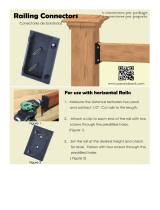
4
5. Once all the steps are assembled onto one of the side rails, position the side rail on its
side with the steps pointing up.
6. Apply a thin film of glue on the ends of each step and in the dado of the other rail, along
with the holes in the sides of the rail (for the top turned rung) and the ends of the top
turned rung.
7. Properly align each step as well as the top turned rail into its corresponding dado/hole,
use the supplied 1-3/4” washer-head screws to fasten the steps into place.
8. To install the step support rods, push a nut cap (used with the step support rods) in the
predrilled hole on the side rail. Slide the step support rod through the hole on the
opposite side rail and partially thread it into the nut cap. Install the other nut cap and
using two 5mm Allen wrenches tighten each side simultaneously so that there is equal
amounts of thread on each end of the rod into each nut cap.
Step 3 Ladder Hardware Installation
Top Ladder Hardware
1. Align the top roller guide on the beveled portion of the top of the ladder so that the top
turned rung is centered between the bolt holes on the side of the hardware.
2. Mark on the beveled flat surface of the ladder, the top of the hardware. Measure from the
tip of the ladder to this mark. Scribe a similar mark on the other ladder side rail so that
the location of the top roller guide will be identical on both of the ladder side rails.
3. Locate the top roller guide onto the ladder rail, lining up this hardware on the scribed
line. Using a Vix bit or similar self-centering drill guide, drill a pilot hole into the edge
of the ladder for the (2) #10 x ¾” Flat-head, Phillips-drive screws, and secure each top
roller guides to the top of the ladder.
4. Using a ¼” drill bit, drill out the holes for the ¼-20 KD bolts on the sides of the ladder.
Recommended procedure for this:
� Using the holes in the top roller guide as a drill guide, drill a ¼” hole half way
through the thickness of the ladder slide rail.
� Drill the same hole on the opposite side of the top roller guide, producing a ¼”
through hole in the ladder side rail.
� Follow this same procedure for all 4 through holes and complete the assembly by
securing the top roller guide with the supplied ¼-20 KD bolts and acorn nuts.
Bottom Ladder Hardware
1. Place the bottom roller housing onto the bottom of the ladder using the “U” bracket
portion of the housing. Verify that the bracket is flush with the bottom of the ladder.
Because of the 12-degree angle of the bottom of the ladder this will align the housing
diagonally across the ladder side rail.
2. Mark the location of the “U” bracket on the bottom of the ladder and at the same time
mark on the side of the ladder the location of the top mounting hole of the bottom roller
housing. Measure these marks and transfer these measurements to the other ladder side
rail so that the hardware will mount identically on both ladder side rails.
3. Using a ¼” drill bit, drill a through hole in the ladder side rail for the ¼-20 KD bolt.
4. Predrill the ladder side rail for the #10 x ¾” screw
5. Install both the bottom roller guides using the included screws and KB bolts and acorn
nuts.











